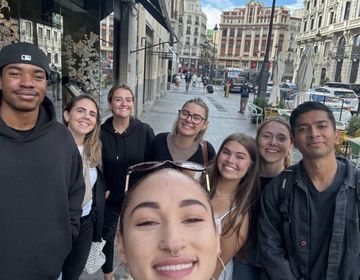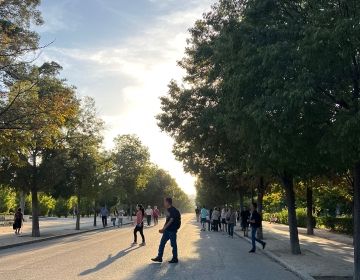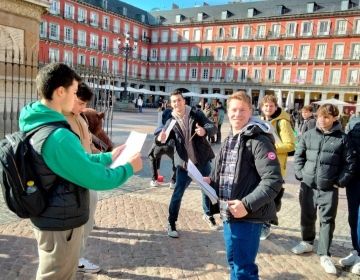Holocaust Studies in Madrid: Street History and Memory
During one of our CIEE walking tours in Madrid, it's hard to keep a moment of silence on a noisy, bustling street of shops, bars, and restaurants. Yet we stop in barrio Lavapiés while our group finds a Holocaust memorial stone, called a Stolperstein. These historical markers are part of some 75,000 Stolpersteine (meaning stumbling stones in German) that have been installed across Europe and identify where victims of Nazi war camps last lived and resided by choice. Each small gold brass stone bears the name of the victim, their date of birth, the date of their camp deportation and when their lives ended – there are so far twelve placed on the streets in Madrid and over a hundred across Spain.

As part of our CIEE course offerings, including the Spanish Civil War in Memory and History class, students learn that around 9,300 Spaniards found themselves imprisoned in Nazi concentration camps during the Second World War and some 5,000 died there. Spanish prisoners were mostly political exiles or Republican sympathizers who fled to France after the civil war ended in 1939 to avoid execution by the Franco regime. But their escape was short-lived. German Nazi soldiers entered France and captured many Spanish refugees, some fifteen thousand of them. They were deported and put to work in prison camps, one of which was Mauthausen in Austria. 
One of the other lessons that CIEE participants learn during the walking tour is that many high school history books have long stated that Spain remained neutral during World War II. Therefore, our introductory Spanish history lessons imply that the Franco regime was not a part of the Holocaust. But remaining neutral in such a heinous crime against humanity is simply not possible, and that is why the Stolpersteine project in Madrid reveals the scope of this trauma. By understanding this local history, we can help students to embrace the meaning of global citizenship, the role of historical memory and create a renewed self-awareness and empathy. 
One of the Holocaust memorial stones that we visit is dedicated to a pastry chef, Manuel García. He was a young Spaniard who lived near the Escuela Pias in the historic working-class area of Lavapiés, starting his patisserie career in 1930. By 1936, he headed up the pastry team at the Hotel Nacional, and had met Carmen, his would-be life partner. But, when the Spanish Civil War started in 1936, García didn’t hesitate for a moment to join the Republican militias to defend his city from Franco’s troops. He fought in the Sierra de Guadarrama, in the Battle of the Ebro. On January 25, 1941, he was captured and sent to Mauthausen: prisoner number 3243. Just a few months later, he was transferred to Gusen in Austria where he died on July 3, 1942, of “pulmonary tuberculosis”.
Nazi war prisoner, Manuel García, bottom left © Family of Manuel [source: Público]

Locations of Madrid´s 12 Stolpersteine (Holocaust Memorial Stones)
Four out of the nearly 450 Spanish prisoners who originally resided in Madrid were women and will eventually be added to the Stolpersteine project. We would like to remember and honor these victims
- ENRIQUE CALCERRADA GUIJARRO: Calle Bravo Murillo, 20
- ANDRÉS FARIÑAS ADSUAR: Calle Viriato, 2
- PEDRO DÍAZ CLEMENTE: Calle Virtudes, 22
- JOSÉ BELLO SÁNCHEZ: Calle Ponzano, 44
- ANTONIO ZURITA MAYO: Calle Espronceda, 7
- EUFEMIO GARCÍA GARCÍA: Calle Francos Rodríguez, 106
- GREGORIO REBOLLO GARCÍA: Calle Nenúfar, 6
- EUSEBIO GONZÁLEZ MONTEALEGRE: Calle Pinos Baja, 3
- JOSÉ FONTANET MORENO: Paseo de Extremadura, 150
- PABLO AGRAZ ALONSO: Calle José Antonio Armona, 4
- MANUEL GARCÍA GARCÍA: Calle Mesón de Paredes, 60
- JUAN ANTONIO GARCÍA ACERO: Calle Huerta del Bayo, 5
Related Posts
My Unforgettable Semester Abroad in Madrid
By: Mariah Kirylo Madrid has been a transformative experience for me, letting me get a sense of the Spanish life/testament to history and allowing academic growth as well developing forever... keep reading
I Speak Spanish! Why Are People Speaking to Me in English?!
By: Sophie Lakin It feels like most of the time I try to talk to anyone in Spanish, they respond to me in English! I began to think if it... keep reading
Madrid as your Spanish Language Lab
Why study Spanish in the classroom when we have Madrid as our language lab? Every week our Open Campus Spanish Language students engage in community activities as part of their... keep reading






